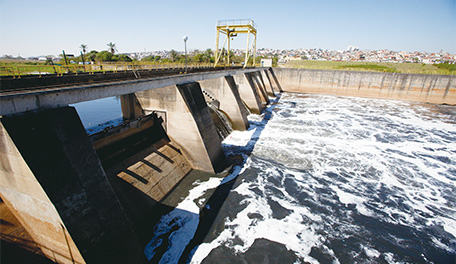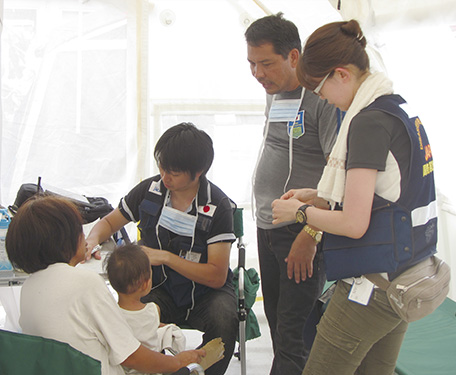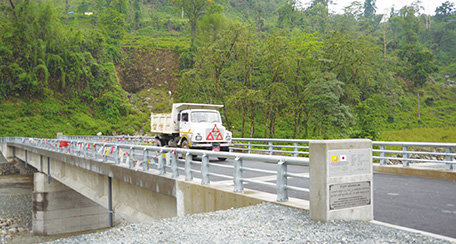Japan's Official Development Assistance White Paper 2013
(5) Cooperation in Disaster Risk Reduction and Emergency Assistance
Disasters caused by earthquakes, tsunamis, typhoons, floods, debris flows, and other natural events that occur frequently in countries around the world do not merely take human lives and properties. In developing countries that are vulnerable to disasters, poor people suffer from significant damage, and become displaced in many cases. In addition, secondary damage such as the deterioration of sanitary conditions and food shortages may become protracted, making the problem more severe. In this respect, disasters have a significant impact on the overall social and economic mechanisms of developing countries.
For these reasons, it is necessary to incorporate disaster risk reduction measures into every phase of every type of development based on assumptions of disasters of various scales, in order to build a disaster resilient society to protect human lives from disasters, as well as promote the “mainstreaming of disaster risk reduction.”
<Japan’s Efforts>
Japan utilizes its superior expertise and technology acquired through past experiences with natural disasters like earthquakes and typhoons to provide proactive support in the fields of disaster prevention and post-disaster reconstruction, as well as emergency aid. In 2005 at the Second UN World Conference on Disaster Reduction in Kobe, the Hyogo Framework for Action 2005-2015 was adopted as a basic guideline for disaster risk reduction activities in the international community, and the importance of effectively incorporating disaster risk reduction aspects into initiatives for sustainable development was confirmed. Japan partners with the United Nations and other organizations to promote worldwide implementation.
At the conference, Japan also announced the Initiative for Disaster Risk Reduction through ODA, which represents Japan’s basic policy on cooperation in disaster risk reduction. Japan expressed its intention to continue proactively supporting the self-help efforts by developing countries towards building a disaster-resilient society through institution building, human resource development, development of socio-economic infrastructure, and other measures.
Japan hosted the World Ministerial Conference on Disaster Reduction in Tohoku on July 3 and 4, 2012 in three prefectures afflicted by the Great East Japan Earthquake. Among topics discussed were the necessity of mainstreaming disaster risk reduction and building resilient societies, the importance of human security, the need to maximize combining both structural and non-structural disaster risk reduction capabilities, the necessity of collaboration beyond the roles of various stakeholders and the importance of responding to newly emerging disaster risks such as climate change and urbanization. The participants proposed “Disaster Risk Reduction in the 21st Century” as the way to make progress on the aforementioned aspects. They also confirmed the need to position disaster risk reduction as an important element in the post-2015 development agenda, as well as the need for formulating the post-Hyogo Framework for Action that incorporates the results of this conference, in order to actually promote “Disaster Risk Reduction in the 21st Century.” Japan also pledged to provide $3 billion in the next three years from 2013 to 2015 to support disaster risk reduction.
In March 2015, the Third World Conference on Disaster Risk Reduction will be held in Sendai City, Japan. The post-Hyogo Framework for Action 2005-2015 is planned to be formulated during this conference. Through the discussions on this issue, Japan intends to contribute to the mainstreaming of disaster risk reduction.

A river channel improvement project was implemented for the total length of 50km, as well as the construction of a water flow control dam in Sao Paulo, Brazil. This reduced flood risks and stabilized the provision of clean water, irrigation water, and industrial water. (Photo: Shinichi Kuno / JICA)
●Japan’s Emergency Assistance
Japan has established a structure to facilitate emergency assistance in response to requests from the government of an affected country or an international organization, when a large scale disaster occurs. Japan has four types of Japan Disaster Relief (JDR) Team to provide humanitarian aid: (i) Search and Rescue Team to search and rescue victims; (ii) Medical Team to provide urgent medical assistance; (iii) Expert Team to give technical advice or guidance on emergency response measures and recovery; and (iv) Self-Defense Force Unit to be dispatched for transportation and relief activities when it has been judged to be particularly necessary when a large-scale disaster occurs.

In November 2013, the Japan Disaster Relief Medical Teams provided medical treatment in the area affected by typhoon Haiyan (Yolanda) in the Philippines. (Photo: JICA)
In addition, Japan provides Emergency Relief Goods as in-kind assistance. Japan stockpiles tents, generators, blankets, and other goods at overseas warehouses in six locations to meet the needs of affected people, and Japan is always prepared to provide relief goods to affected countries when a disaster occurs.
Moreover, to provide support for displaced persons or people affected by natural disasters and/or conflicts, Japan disburses the Emergency Grant Aid for the governments of affected countries or international and other organizations including Red Cross Societies which provide emergency assistance in areas affected by disasters.
In FY2012, Japan sent Emergency Relief Goods on a total of 17 occasions to 16 countries, including the Philippines, Nigeria and Fiji.
Also in FY2012, Japan provided approximately ¥3.5 billion in Emergency Grant Aid as emergency disaster assistance to a total of 10 countries, including Pakistan, the Philippines and Haiti, in order to provide support for the people affected by natural disasters, as well as Syrian refugees and internally displaced persons. For example, in response to flooding in Pakistan, Japan contributed $4.7 million through international organizations to support the provision of food, emergency supplies, as well as water and sanitation facilities.
In response to the typhoon disaster that hit the central Philippines in November 2013, Japan provided approximately ¥60 million worth of emergency relief supplies (such as plastic sheets) and $30 million (approximately ¥3 billion) in Emergency Grant Aid. In addition, Japan deployed Medical Teams, Self-Defense Force Units and Expert Teams (experts of early recovery and oil-spill prevention). The Self-Defense Force Units were dispatched consisted of approximately 1,200 personnel, the largest ever, and it conducted activities such as medical assistance, epidemic prevention, and transportation of affected-people and relief goods.
(As of December 4, 2013)

Self-Defense Force personnel participating in disaster relief activities in the affected area of the Philippines talking to local children.
●Collaboration with International Organizations
Japan provides cooperation to the “Global Facility for Disaster Reduction and Recovery” established in the World Bank in 2006. This Facility aims at supporting efforts to improve the ability for disaster risk reduction planning and post-disaster reconstruction in low and middle-income countries that are vulnerable to natural disasters.
With the increase in recognition of the importance of disaster risk reduction, representatives from countries all over the world and from UN organizations such as the World Bank that are involved in disaster risk reduction gathered at a meeting of the UN General Assembly in 2006. At the meeting, the Global Platform for Disaster Risk Reduction was established to facilitate discussions regarding disaster risk reduction. The first meeting of the Global Platform was held in June 2007. Japan proactively supports the activities of the UN International Strategy for Disaster Reduction (UNISDR), which serves as the secretariat for the Global Platform. The Hyogo Office of the UNISDR was opened in October 2007.
The fourth session of the Global Platform for Disaster Risk Reduction was held in May 2013 in Geneva, Switzerland. More than 3,500 delegates representing 172 governments, NGOs and private organizations participated in the meeting. Japan announced that it would host the Third UN World Conference on Disaster Risk Reduction in Sendai City, Japan.
Eight years have passed since the Second World Conference on Disaster Reduction in Kobe, and Japan has been engaged proactively in the follow-up efforts on the Hyogo Framework for Action, which serves as the basic guideline for disaster risk reduction activities in the international community, while utilizing the forums provided by meetings of the Global Platform.
Japan is also supporting the ASEAN Coordinating Centre for Humanitarian Assistance on Disaster Management (AHA Centre) by providing communication equipment and dispatching personnel as well as providing emergency relief goods and supporting for establishing a goods management and distribution system.
●Bhutan
The Project for Restoration and Improvement of Vital Infrastructure for Cyclone Disaster
Grant Aid (August 2011 - March 2013)
Steep mountains cover most of Bhutan. Consequently, the country has underdeveloped air and rail systems, and travel and transportation are highly dependent upon the road network. When Cyclone Aila hit South Asia in the end of May 2009, roads and bridges throughout Bhutan were destroyed, cutting access to markets, hospitals, schools and other essential facilities necessary for everyday life.
Some of the bridges required repairs that were beyond the technical capabilities of local repairers, which in turn delayed recovery. In light of this situation, Japan decided to support the replacement of five bridges, including some affected by the Cyclone and structurally weak bridges that may be susceptible to future weather events. One of the first projects was the replacement of three bridges connecting farming areas with National Road No. 4 in the Trongsa District, located in central Bhutan. Establishing a link between the national road and the local communities vitalized the economic activities of residents in the areas.
Furthermore, the replacement of two bridges on National Road No. 5 in Sarpang District increased their resistance to natural disaster. These projects also increased the bridges’ maximum load from 18 tons to 40 tons as well as increasing them from one to two lanes. These projects have increased the performance of the national road network and have helped to enhance logistics operations within the country.

A replaced bridge that has increased resistance to natural disaster (Photo: JICA)
